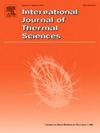氨-氢-甲烷混合物热表面点火延迟时间
IF 5
2区 工程技术
Q1 ENGINEERING, MECHANICAL
International Journal of Thermal Sciences
Pub Date : 2025-03-19
DOI:10.1016/j.ijthermalsci.2025.109885
引用次数: 0
摘要
在本研究中,通过详细的机理数值研究了在两个恒定温度(1400 K和1600 K)下,向化学计量甲烷-空气混合物中加入氢和氨以及向化学计量氢-空气混合物中加入氨对热表面附近点火延迟时间变化的影响。本文定义了氢-甲烷效率极限(HMEL),即氢对减少点火延迟时间的有利作用被逆转,导致点火延迟时间比原始化学计量甲烷-空气混合物更长。此外,氢-甲烷最佳范围(HMOR)代表了在化学计量甲烷-空气混合物中达到最低点火延迟时间的最佳氢气添加范围。在1600 K的热表面温度下,当加入约14.5%的氢时,观察到甲烷-氢-空气混合物的点火延迟时间有不可预测的跳跃。此外,在较高的热表面温度下,添加超过16%的氢会导致更长的点火延迟时间。相反,在甲烷和氢气混合物中加入氨气后,点火延迟时间增加。此外,还得出结论,在化学计量氢-空气混合物中加入超过23 - 25%的氨,使其在1600k的热表面上不可燃。该研究突出了氢和氨添加对点火延迟时间的影响,为实际应用提供了有价值的见解,并为进一步研究燃料,特别是氨和氢的燃烧特性提供了基础。本文章由计算机程序翻译,如有差异,请以英文原文为准。
Hot surface ignition delay time of ammonia-hydrogen-methane mixtures
In this research, the effects of adding hydrogen and ammonia to the stoichiometric methane-air mixture, as well as adding ammonia to the stoichiometric hydrogen-air mixture, on ignition delay time changes near a hot surface at two constant temperatures (1400 K and 1600 K) are numerically investigated using a detailed mechanism. The hydrogen-to-methane effectiveness limit (HMEL) is defined in this paper, indicating the point at which the beneficial effect of hydrogen on reducing ignition delay time is reversed, resulting in longer ignition delay times compared to the original mixture, stoichiometric methane-air. Additionally, the hydrogen-to-methane optimal range (HMOR) represents the optimal hydrogen addition range to the stoichiometric methane-air mixture that achieves the lowest ignition delay times. An unpredictable jump in ignition delay time is observed in the methane-hydrogen-air mixture at a hot surface temperature of 1600 K when approximately 14.5 % hydrogen is added. Additionally, adding more than 16 % hydrogen results in longer ignition delay times at higher hot surface temperatures. Conversely, the ignition delay time increases with addition of ammonia in both methane and hydrogen mixtures. Furthermore, it is concluded that adding more than 23–25 % ammonia to the stoichiometric hydrogen-air mixture renders it non-ignitable by a hot surface at 1600 K. This study highlights the impact of hydrogen and ammonia addition on ignition delay time, offering valuable insights for practical applications and providing a foundation for further research on the combustion characteristics of fuels, particularly ammonia and hydrogen.
求助全文
通过发布文献求助,成功后即可免费获取论文全文。
去求助
来源期刊

International Journal of Thermal Sciences
工程技术-工程:机械
CiteScore
8.10
自引率
11.10%
发文量
531
审稿时长
55 days
期刊介绍:
The International Journal of Thermal Sciences is a journal devoted to the publication of fundamental studies on the physics of transfer processes in general, with an emphasis on thermal aspects and also applied research on various processes, energy systems and the environment. Articles are published in English and French, and are subject to peer review.
The fundamental subjects considered within the scope of the journal are:
* Heat and relevant mass transfer at all scales (nano, micro and macro) and in all types of material (heterogeneous, composites, biological,...) and fluid flow
* Forced, natural or mixed convection in reactive or non-reactive media
* Single or multi–phase fluid flow with or without phase change
* Near–and far–field radiative heat transfer
* Combined modes of heat transfer in complex systems (for example, plasmas, biological, geological,...)
* Multiscale modelling
The applied research topics include:
* Heat exchangers, heat pipes, cooling processes
* Transport phenomena taking place in industrial processes (chemical, food and agricultural, metallurgical, space and aeronautical, automobile industries)
* Nano–and micro–technology for energy, space, biosystems and devices
* Heat transport analysis in advanced systems
* Impact of energy–related processes on environment, and emerging energy systems
The study of thermophysical properties of materials and fluids, thermal measurement techniques, inverse methods, and the developments of experimental methods are within the scope of the International Journal of Thermal Sciences which also covers the modelling, and numerical methods applied to thermal transfer.
 求助内容:
求助内容: 应助结果提醒方式:
应助结果提醒方式:


